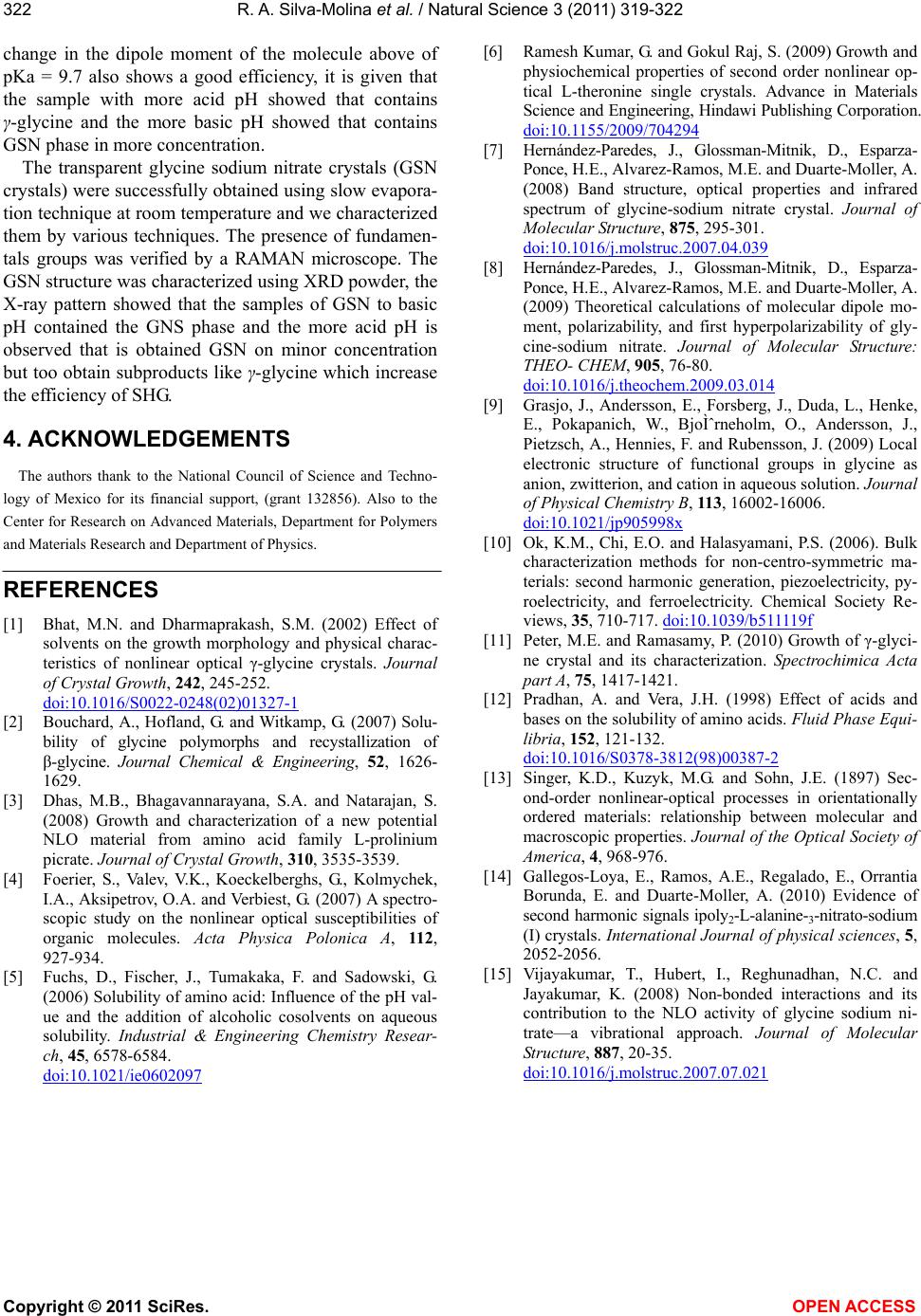
R. A. Silva-Molina et al. / Natural Science 3 (2011) 319-322
Copyright © 2011 SciRes. OPEN ACCESS
322
change in the dipole moment of the molecule above of
pKa = 9.7 also shows a good efficiency, it is given that
the sample with more acid pH showed that contains
γ-glycine and the more basic pH showed that contains
GSN phase in more concentration.
The transparent glycine sodium nitrate crystals (GSN
crystals) were successfully obtained using slow evapora-
tion technique at room temperature and we characterized
them by various techniques. The presence of fundamen-
tals groups was verified by a RAMAN microscope. The
GSN structure was characterized using XRD powder, the
X-ray pattern showed that the samples of GSN to basic
pH contained the GNS phase and the more acid pH is
observed that is obtained GSN on minor concentration
but too obtain subproducts like γ-glycine which increase
the efficiency of SHG.
4. ACKNOWLEDGEMENTS
The authors thank to the National Council of Science and Techno-
logy of Mexico for its financial support, (grant 132856). Also to the
Center for Research on Advanced Materials, Department for Polymers
and Materials Research and Department of Physics.
REFERENCES
[1] Bhat, M.N. and Dharmaprakash, S.M. (2002) Effect of
solvents on the growth morphology and physical charac-
teristics of nonlinear optical γ-glycine crystals. Journal
of Crystal Growth, 242, 245-252.
doi:10.1016/S0022-0248(02)01327-1
[2] Bouchard, A., Hofland, G. and Witkamp, G. (2007) Solu-
bility of glycine polymorphs and recystallization of
β-glycine. Journal Chemical & Engineering, 52, 1626-
1629.
[3] Dhas, M.B., Bhagavannarayana, S.A. and Natarajan, S.
(2008) Growth and characterization of a new potential
NLO material from amino acid family L-prolinium
picrate. Journal of Crystal Growth, 310, 3535-3539.
[4] Foerier, S., Valev, V.K., Koeckelberghs, G., Kolmychek,
I.A., Aksipetrov, O.A. and Verbiest, G. (2007) A spectro-
scopic study on the nonlinear optical susceptibilities of
organic molecules. Acta Physica Polonica A, 112,
927-934.
[5] Fuchs, D., Fischer, J., Tumakaka, F. and Sadowski, G.
(2006) Solubility of amino acid: Influence of the pH val-
ue and the addition of alcoholic cosolvents on aqueous
solubility. Industrial & Engineering Chemistry Resear-
ch, 45, 6578-6584.
doi:10.1021/ie0602097
[6] Ramesh Kumar, G. and Gokul Raj, S. (2009) Growth and
physiochemical properties of second order nonlinear op-
tical L-theronine single crystals. Advance in Materials
Science and Engineering, Hindawi Publishing Corporation.
doi:10.1155/2009/704294
[7] Hernández-Paredes, J., Glossman-Mitnik, D., Esparza-
Ponce, H.E., Alvarez-Ramos, M.E. and Duarte-Moller, A.
(2008) Band structure, optical properties and infrared
spectrum of glycine-sodium nitrate crystal. Journal of
Molecular Structure, 875, 295-301.
doi:10.1016/j.molstruc.2007.04.039
[8] Hernández-Paredes, J., Glossman-Mitnik, D., Esparza-
Ponce, H.E., Alvarez-Ramos, M.E. and Duarte-Moller, A.
(2009) Theoretical calculations of molecular dipole mo-
ment, polarizability, and first hyperpolarizability of gly-
cine-sodium nitrate. Journal of Molecular Structure:
THEO- CHEM, 905, 76-80.
doi:10.1016/j.theochem.2009.03.014
[9] Grasjo, J., Andersson, E., Forsberg, J., Duda, L., Henke,
E., Pokapanich, W., Björneholm, O., Andersson, J.,
Pietzsch, A., Hennies, F. and Rubensson, J. (2009) Local
electronic structure of functional groups in glycine as
anion, zwitterion, and cation in aqueous solution. Journal
of Physical Chemistry B, 113, 16002-16006.
doi:10.1021/jp905998x
[10] Ok, K.M., Chi, E.O. and Halasyamani, P.S. (2006). Bulk
characterization methods for non-centro-symmetric ma-
terials: second harmonic generation, piezoelectricity, py-
roelectricity, and ferroelectricity. Chemical Society Re-
views, 35, 710-717. doi:10.1039/b511119f
[11] Peter, M.E. and Ramasamy, P. (2010) Growth of γ-glyci-
ne crystal and its characterization. Spectrochimica Acta
part A, 75, 1417-1421.
[12] Pradhan, A. and Vera, J.H. (1998) Effect of acids and
bases on the solubility of amino acids. Fluid Phase Equi-
libria, 152, 121-132.
doi:10.1016/S0378-3812(98)00387-2
[13] Singer, K.D., Kuzyk, M.G. and Sohn, J.E. (1897) Sec-
ond-order nonlinear-optical processes in orientationally
ordered materials: relationship between molecular and
macroscopic properties. Journal of the Optical Society of
America, 4, 968-976.
[14] Gallegos-Loya, E., Ramos, A.E., Regalado, E., Orrantia
Borunda, E. and Duarte-Moller, A. (2010) Evidence of
second harmonic signals ipoly2-L-alanine-3-nitrato-sodium
(I) crystals. International Journal of physical sciences, 5,
2052-2056.
[15] Vijayakumar, T., Hubert, I., Reghunadhan, N.C. and
Jayakumar, K. (2008) Non-bonded interactions and its
contribution to the NLO activity of glycine sodium ni-
trate—a vibrational approach. Journal of Molecular
Structure, 887, 20-35.
doi:10.1016/j.molstruc.2007.07.021